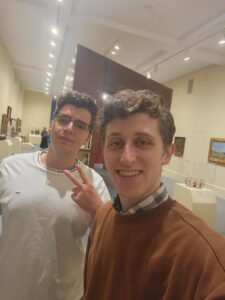The first thing I was looking forward to this night was reuniting with my high school friend. I found him with one of his friends he met from Macaulay that I didn’t really know who he was at the time. We went to the auditorium, and I was excited to see what the museum had to offer after they said we were one of the first groups being exposed to this new floor they were working on. Although the art pieces were visually appealing, they didn’t really communicate anything to me.
- Canopic Jars and Covers of Tjuli
When first seeing this, I saw a nice detailed sculpture of heads representing gods on top of the jar lid. After reading the description, I learned that they stuffed organs in them, which was shocking. This reminded me of a funeral process I learned about in AP World History. I don’t remember specifically which culture it was, but before mummifying the dead body, they took out its organs and stuffed them into a jar. I think this perfectly represents the question they shared in the auditorium, which asked something similar to “what if descriptions change beautiful sculptures into violent art pieces”.
- Cartonnage of Nespanetjerenpare
This art piece showed how the definition of red was different back in the day. When I first looked at this, I thought it represented someone evil and intimidating because of the red skin color, but according to the description, it represented resurrection, permanence, stability, and endurance. This shows how colors had different meanings back then.
Other than these art pieces, none of the other ones caught my attention as much as these two. The greatest thing that happened in this museum is that I realized my high school friends Macaulay friend was Polish, and he knew how to speak it, so we instantly became friends. Other than that, I didn’t really enjoy the museum aspect of this trip.





